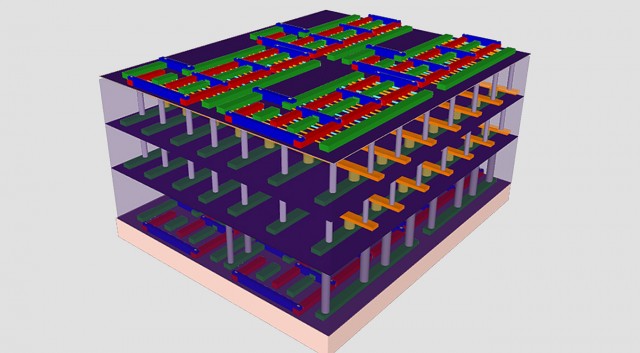
Stanford researchers led by Mohamed M. Sabry Aly, Subhasish Mitra, and H.-S. Philip Wong developed a skyscraper computer chip with the idea of stacking application processors, memory modules, and other components on top of each other in “a revolutionary new high-rise architecture for computing.”
For decades, engineers have designed computer systems with processors and memory chips laid in single-story structures. Wires connect these chips and carry digital traffic between the processors that compute the data and memory chips that store it.
Stacking chips has long been viewed as a more practical path towards efficiency and powerful computing architecture over the current outline that lays out and connects components on a flat board. However, building a “skyscraper” chip has proven to be difficult using silicon-based integrated circuits that are tough to connect.

Now, the research team has uncovered a way around the issue using new nano-materials to construct computer chips in place of silicon ICs. Its Nano-Engineered Computing Systems Technology, deemed N3XT, uses a process that involves building carbon nanotube transistors (CNTs) in a stacked arrangement. Instead of a limited number of wires connected to stacked silicon chips, a N3XT device will employ “millions of electronic elevators that can move more data over shorter distances than traditional wire, using less energy.” The skyscraper-style chip will also incorporate cooling to keep the thermals in check and prevent overheating, and has the capability to power computers at higher speeds by a factor of one thousand.
Rather than adding traditional wires to connect stacked chips in a N3XT system, communication between the components is built in during the process of fabrication. As CNTs are able to be created at lower temperatures than silicon-based transistors, it is possible to build components on top of one another. Silicon ICs have to be fabricated separately from each other and then stacked in a 3D arrangement later.
One setback to the introduction of chip-stacking technologies such as N3XT is the huge investment there already is in silicon-based technology by the global semiconductor industry.
“Shifting electronics from a low-rise to a high-rise architecture will demand huge investments from the industry,” the researchers said.
But the incentive to do so is high as this computational horsepower could unveil volumes of data relevant to some of the world’s biggest issues including health care and climate change.
Source: Extreme Tech
Advertisement
Learn more about Electronic Products Magazine





